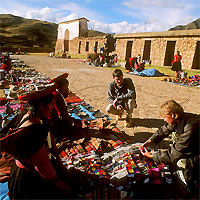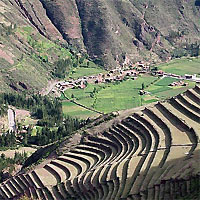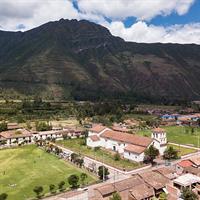The Sacred Valley of the Incas
Introduction
The Sacred Valley of the Incas, or in Spanish "El Valle Sagrado de los Incas", is an incomparable stretch of small villages and extraordinary ruins spanning the heartland of ancient Incan society between the centers of Cuzco and Machu Picchu. The valley is defined by the meandering course of the Urubamba River as it rambles across terraced hillsides, broad plains. and rugged mountain slopes. This great fertile expanse was the nucleus of the empire's prodigious agricultural production. The villages from Pisac to Ollantaytambo remain starkly traditional, with Quechua-speaking residents working the fields using primitive tools and methods, unchanged since the days of the Incas.

Calca
Calca is a beautiful hamlet with wonderful mountain views, and is close to the medicinal spas and thermal sulfurous springs of Machacancha and Minasmoqo.

Chinchero
Chinchero is a small charming village believed to be the mythical birthplace of the rainbow, is comprised of mud brick adobe houses with locals in traditional dress and has been voted as having the Best Indian Market.

Ollantaytambo
Ollantaytambo is a town built on top of original Inca foundations and divided into canchas (blocks) with entrances leading into central courtyards, is considered to be one of the most important living museums in the world, with locals maintaining ancestral customs.

Pisac
Pisac is a rustic Andean village known for its Incan Ruins atop a hill at the entrance into the valley and for its picturesque artisan market.

Urubamba
Urubamba is located under a snow-capped mountain near the river of the same name, is the largest town in the valley, home to a number of significant ruins and to the internationally known Seminario Ceramics.

Yucay
Yucay is a fertile village whose name translates to "bewitchment," was the elected resort for the Inca royalty and one of the main centers of agricultural production.